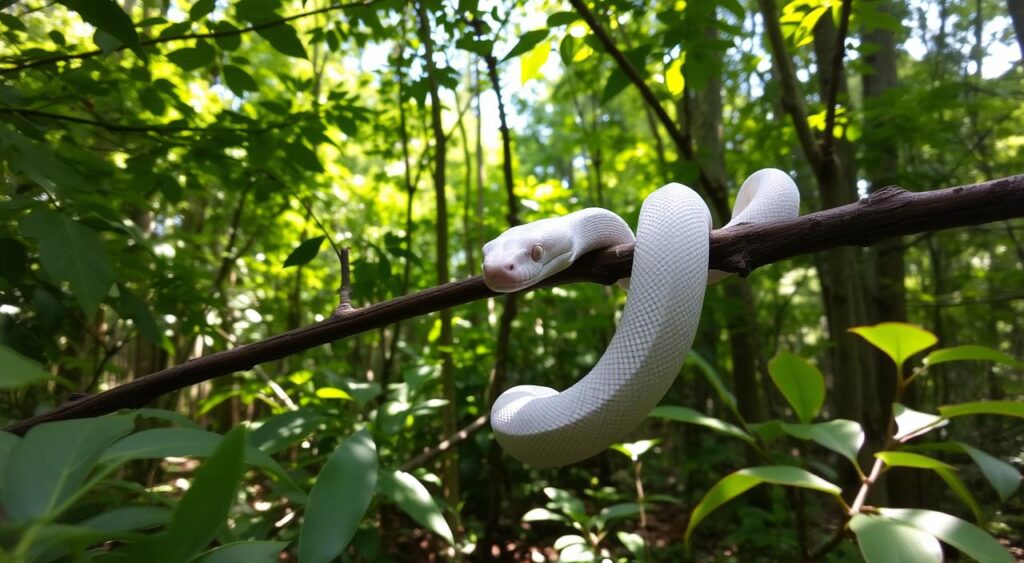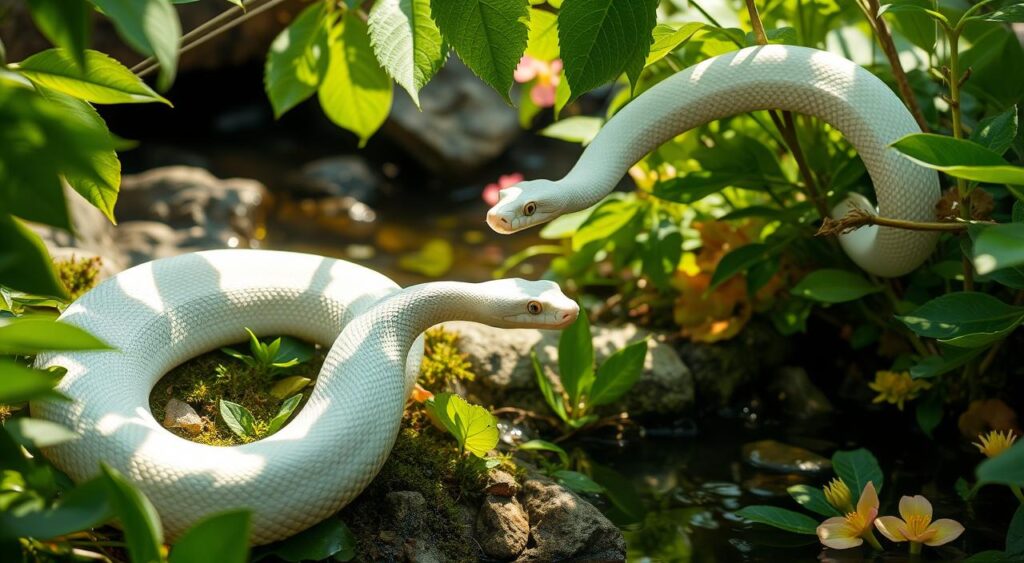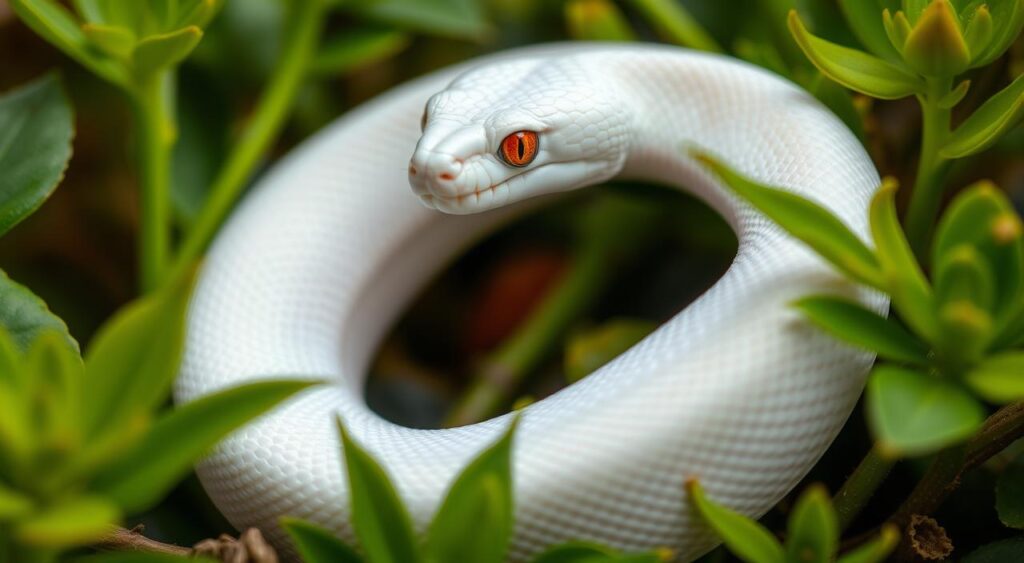Did you know there are seven different types of albino snakes? Species like the California King Snake and the White Cobra Snake are rare and fascinating. They have red eyes and white scales, making them stand out among other snakes. Their unique look comes from their genetics and brings both beauty and challenges for their care.
This article will explore the world of albino snakes. We’ll look at their background, the variety of species, how they eat, where they live, and how to care for them. Whether you’re an expert or just interested, you’ll find the beauty and mystery of these snakes captivating. Let’s dive into the world of these unique reptiles together!

Introduction to Albino Snakes
Albino snakes are known for their unique look and unique characteristics. They have pale skin and red or pink eyes. This is because they don’t make melanin, unlike other snakes.
Many people find albino snakes very attractive. The albino corn snake, for example, can be 2 to 6 feet long and weighs less than a pound. They can live up to 15 to 20 years in captivity, making them long-lived pets.
Albino corn snakes have special ways of defending themselves, like tail vibrations when scared. They need a big enclosure with lots of room and places to hide. This shows how special albino snakes are and why people love them.

Characteristics of Albino Snakes
Albino snakes have unique and striking physical traits. They are a fascinating study subject for herpetologists and enthusiasts. Their most notable feature is their white and yellow scales. This comes from a genetic mutation that stops melanin production.
This lack of melanin makes them visually captivating, especially in species like the Albino Ball Python. Their scales shimmer in the light, showing off various patterns that add to their beauty.
Albino snakes are known for their striking red eyes. This is because they don’t have melanin. These red eyes stand out against their pale bodies, adding to their allure. The vibrant coloration and unique eyes make them a captivating sight.
The behavior of albino snakes is also worth noting. They are calm and docile, making them great pets for reptile lovers. These snakes like to hide and need secure habitats that mimic their natural setting. This helps keep them stress-free. Their interesting behaviors and looks have made them popular in the reptile world.
| Characteristic | Description |
|---|---|
| Coloration | White and yellow scales due to lack of melanin |
| Eyes | Distinctive red eyes, a result of albinism |
| Lifespan | Approximately 30 years |
| Temperament | Docile and calm, suitable as pets |
| Primary Diet | Rodents |

Albino Snake Species Overview
The world of albino snakes is full of interesting choices for those who love reptiles. There are many albino snake species, each with its own unique traits. The Albino Ball Python, Albino Corn Snake, and Albino Burmese Python are favorites among enthusiasts. They all have different looks and care needs.

Albino Ball Pythons are loved for their white and yellow look, caused by a lack of melanin. They grow 3 to 5 feet long and can live about 30 years. They need a big tank, should be kept in temperatures of 76 to 93°F, and have humidity of 50 to 60%. Feeding them rodents is key to their health.
Albino Corn Snakes are another great choice. They are about 4 to 5 feet long and can live 15 to 20 years. They do well in a 20-gallon tank, liking temperatures of 75 to 85°F. They eat small to medium-sized mice and rats, making them popular pets. Female Corn Snakes can lay 12-24 eggs, making them interesting for breeders.
Looking at different albino snake species shows their unique looks and care needs. When choosing a snake, think about what you can provide for it. This will help you pick the right species for your home and lifestyle.
| Albino Snake Species | Length | Lifespan | Minimum Tank Size | Temperature Range (°F) | Humidity Level | Diet | Price Range |
|---|---|---|---|---|---|---|---|
| Albino Ball Python | 3-5 ft | 30 years | 55 gallons | 76-93 | 50-60% | Rodents | $100 – $300 |
| Albino Corn Snake | 4-5 ft | 15-20 years | 20 gallons | 75-85 | 65-75% | Small/medium mice and rats | $40 – $100 |
| Albino Burmese Python | 6-12 ft | 20-30 years | 100 gallons | 75-90 | 50-70% | Large rodents, rabbits | $500 – $1,500 |
Albino Snake: The Genetic Mystery
The study of albino snakes is very interesting, especially when looking at their genetics. Albinism in reptiles comes from a mutation that changes how they get their color. Albino snakes don’t make enough melanin, which is why they look white and yellow. This lack of color is mainly because of certain genes that stop melanin from being made.
Knowing about these genes is important for many reasons. It helps with breeding albino snakes in a responsible way. For example, breeding an albino snake with a regular snake might seem like nothing’s different at first. But, the babies could have the albino gene. This way, we keep the albino trait and avoid health problems from too much inbreeding.
Looking at breeding strategies shows how important they are. Pairing two albino snakes can lead to different kinds of babies. You might get normal, albino, or het snakes, which carry the albino gene. These details are key to saving these interesting reptiles. Also, different morphs like the Newport or Lavender albino let us see how genes affect color and patterns.
Studies show that albino snakes like the Coimbatore albino cobra might not be more at risk from predators because of their color. It’s important to understand how the environment affects these snakes to help them survive in the wild or in captivity.

| Factor | Description |
|---|---|
| Genetic Markers | Specific genes responsible for albinism affecting melanin production. |
| Breeding Practices | Methodologies for ensuring genetic diversity and avoiding health issues. |
| Offspring Outcomes | Distribution of traits in offspring based on parent genetics. |
| Survivability Factors | Environmental influences that may affect predator-prey dynamics. |
| Common Species | Albino Ball Pythons, Lavender albinos, Newport morphs. |
Feeding Habits of Albino Snakes
Understanding how to feed albino snakes is key for their care. They mainly eat rodents and have specific needs. Feeding them right helps them grow and stay healthy. It also prevents diseases related to their diet.
Dietary Requirements and Nutritional Needs
Albino snakes, like the Albino Ball Python, eat mostly rodents. Whole prey gives them the nutrients they need to grow and stay healthy. It’s important to pick the right size prey for their age to ensure they get enough nutrients. For example:
| Age of Snake | Prey Type | Feeding Frequency |
|---|---|---|
| Hatchling | Pinkie Mice | Twice a week |
| Juvenile (up to 7 months) | Hopper Mice | Once a week |
| Adult | Adult Mice or Rats | Once every week or two |
It’s best to avoid live prey to prevent stress for both the snake and the prey. Teaching the snake to eat pre-killed food is a kinder approach.
Feeding Schedule for Optimal Health
Having a regular feeding schedule is important for albino snakes. Young snakes eat more often, while adults eat less. Female snakes may need more food before they breed. Watching how often they eat helps spot any problems, like stress or changes in their environment.
Always make sure they have fresh, clean water to drink. Watching how they react during meals helps make their space comfortable for them. If they stop eating, check the temperature, humidity, and stress levels in their home.
Creating an Ideal Habitat for Albino Snakes
Creating a great home for albino snakes means meeting their specific needs for health and happiness. A good snake enclosure gives them room to move and feels safe, like their natural home. It’s important to pay attention to temperature and humidity levels to keep them healthy. Here are the key things to think about.
Enclosure Essentials and Setup
For albino ball pythons, a 55-gallon tank is perfect. This size lets them grow comfortably, as they can be 3 to 5 feet long. The tank should have:
- Suitable substrate like cypress mulch, leaf litter, or long fiber sphagnum to keep moisture in.
- Hiding spots and things like branches to encourage natural behavior.
- A top that covers 90% of the tank to keep heat and humidity in.
Temperature and Humidity Control
Keeping the right temperature is key. Albino ball pythons do best in a temperature range of 76°F to 93°F, with the hottest spot at 90°F. They like humidity levels of 50% to 60%, but it can go up to 70% when they shed their skin. It’s important to have stable temperatures and humidity before putting the snake in its new home.
Use an infrared temperature gun and digital hygrometer to check the conditions. SensorPush tiles or similar gadgets let you monitor things from afar. But, don’t use misting systems unless you’re away for a long time, as it can make the humidity too high.
| Aspect | Recommended Range | Notes |
|---|---|---|
| Enclosure Size | 55 gallons | For comfort and activity |
| Temperature Range | 76°F – 93°F | Hot side below 90°F |
| Humidity Levels | 50% – 60% | Up to 70% during shedding |
| Substrate Options | Cypress mulch, leaf litter, long fiber sphagnum | Helps retain moisture |
| Monitoring Tools | Infrared thermometer and digital hygrometer | For accurate readings |
By paying attention to these details, you can make a great home for albino snakes. This will help them stay healthy and happy.
Care Tips for Albino Snakes
Caring for albino snakes means paying close attention to their health. Regular health checks are key to keeping your pet in top shape. Spotting signs of sickness early can stop bigger problems later. Watch for changes in behavior, skin shedding, and how active they are.
Health Monitoring and Signs of Illness
Keep an eye on your albino snake’s behavior. Look out for these signs of sickness:
- Lethargy or reduced activity levels
- Abnormal shedding or retained skin
- Loss of appetite
- Unusual weight loss or gain
- Dullness in skin color
Being proactive with care is important. Regular checks can catch these signs early. It’s a good idea to take your snake to the vet often. A reptile expert can check your snake’s health and give advice.
Creating a good home for your snake is key to its health. Make sure their home has the right humidity and temperature. Albino snakes need humidity of 50% to 60% and a temperature of 76°F to 93°F. These conditions help them stay healthy and happy.
Good snake care tips mean a balanced diet, a great home, and regular health checks. Keeping an eye on your snake’s health stops problems before they start. These steps make a better life for your albino snake.
The Beauty of Rare Albino Snakes
Rare albino snakes have a unique look that captures the heart. They have white scales with hints of yellow or pink. This makes them stand out and win over fans and new admirers.
The Albino Cobra is a standout among these snakes. Found in India, China, and Vietnam, they can be up to 8 feet long. They change color as they grow, turning white as adults.
Albino reptiles are more than just pretty. They help keep the environment balanced by controlling rodent numbers. Seeing them in the wild is rare, adding to their mystery.
Hector, an albino Western diamondback rattlesnake, is a famous example. He spent over 20 years teaching at Arizona State University. He taught many about the beauty and importance of rare albino snakes.
These snakes are loved for their looks and stories. Their unique traits and tales win hearts, making them some of nature’s most beautiful creations.
Common Misconceptions about Albino Snakes
Albino snakes are often misunderstood, with myths about their health and behavior. It’s important to look closer at these beliefs to know what’s true and what’s not.
Many think all albino snakes have serious health problems. But, not every albino snake is unhealthy. Myths debunked show that with the right care, albino snakes can do well in captivity.
Some believe albino snakes can’t hunt or hide as well as regular snakes. But, understanding albino reptiles reveals they behave similarly. They just look different.
It’s also thought that albino reptiles, like albino alligators, don’t last long in the wild. Albino alligators often don’t make it past a day. This is because they can’t hide well and are sensitive to UV rays. This belief comes from rare cases, not all albino snakes.
Some think all albino snakes are bred in captivity because they’re rare and valuable. While many are bred, some albino snakes are found naturally. This raises questions about their genetics and health.
To truly understand albino snakes, we must clear up these myths. This knowledge helps with responsible ownership and respect for these unique reptiles. It also helps us understand their needs in the wild and in captivity.
Conclusion
Learning about albino snakes shows us their unique traits and needs. These reptiles catch the eye of many fans. To care for them, one needs dedication and the right knowledge.
They need a big tank, like a 55-gallon one, and the right temperature and humidity. This is key to their health.
Albino snakes can live up to 30 years, making them great long-term pets. They eat mostly rodents. A healthy snake has shiny scales and sheds its skin regularly.
It’s important to watch for signs of sickness, like being tired or not eating. If you see these, they might be sick and need help right away.
More people are getting albino snakes as pets. Final thoughts on albino snakes highlight their beauty and the challenges they face. They are hard to see in the wild because they don’t blend in well. This makes us value them more and support efforts to protect them.
Additional Resources
Snake lovers can find many resources to learn more about albino snakes. Websites, forums, and articles offer great insights on care and breeding. Reptile communities are great places to share experiences and learn from others.
Books on albino snakes are also a great way to learn. They cover different species, genetics, and how to care for snakes. Written by experts, these books delve into the world of albino ball pythons and other morphs.
These resources are perfect for both new and experienced snake owners. They help you understand albino snakes better and promote responsible ownership. By diving into these resources, you can deepen your knowledge and support conservation efforts.
FAQ
What are albino snakes and what makes them unique?
Albino snakes have a genetic mutation that makes them lack pigmentation. This results in their striking white or pale look and red or pink eyes. They stand out in the reptile world.
What are the most popular species of albino snakes?
The Albino Ball Python, Albino Corn Snake, and Burmese Python are popular. Each has unique traits and sizes that appeal to different pet owners.
How should I care for an albino snake?
Take care of an albino snake by giving it a proper habitat. This means the right enclosure size, correct temperature and humidity, and a consistent feeding schedule. Feed it rodents that match its age and size.
What are the dietary requirements for albino snakes?
Albino snakes eat rodents. The size of the prey depends on the snake’s age and size. It’s important to feed them a balanced diet regularly to keep them healthy.
Are albino snakes good pets for beginners?
Yes, albino snakes like the Albino Ball Python are calm and manageable. They are great pets for beginners and reptile lovers.
How can I create an ideal habitat for my albino snake?
Create a great habitat by choosing the right enclosure size and substrate. Add hiding spots and ensure the temperature and humidity are right. This should mimic their natural environment.
What common health issues do albino snakes face?
Albino snakes can get respiratory infections, parasites, and shedding problems. Watch for signs like lethargy or abnormal shedding. Catching health issues early is key to their well-being.
What are some misconceptions about albino snakes?
Some think albino snakes are unhealthy or have behavioral problems. But with the right care and environment, they can be healthy and act like normal snakes.
How can I learn more about caring for albino snakes?
For more information, check out online forums, websites about snake care, and books on albino snakes. These resources offer lots of tips on their care and conservation.




